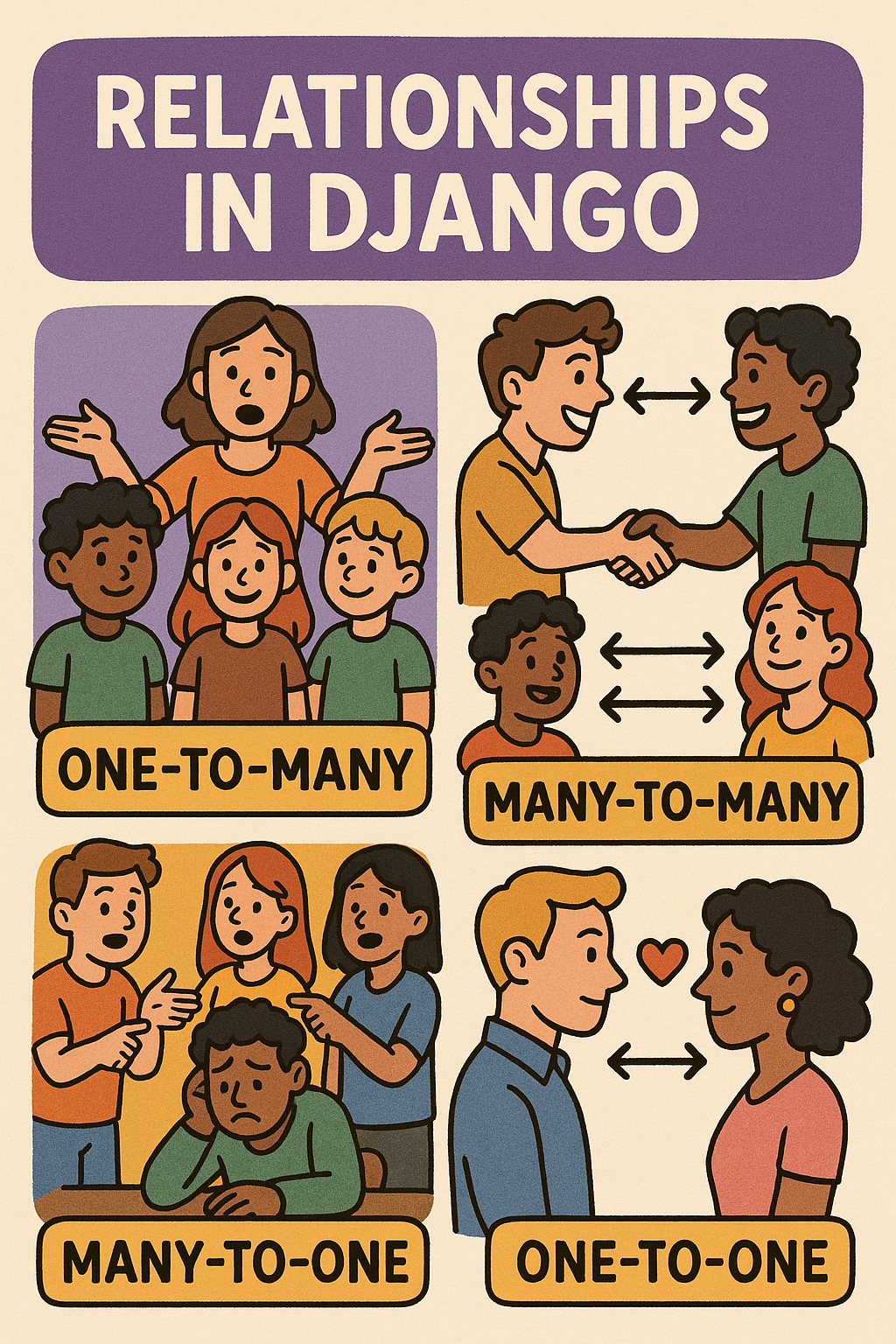Django Models: The Love, Lies, and Foreign Keys of Data Relationships 💔💘
Explore Django relationships through humor, drama, and relatable real-life scenarios. A fun guide to all Django model relationships including One-to-Many, Many-to-Many, Many-to-One, and One-to-One.
Welcome to the scandalous world of Django models, where relationships can be simple, complicated, or downright messy—just like real life. 😏
Think of Django models as characters in a soap opera. Some stay loyal (One-to-One 💍), some have many connections (Many-to-Many 💃🕺), and others are just trying to keep their family together (One-to-Many 👨👩👧👦). Some try to keep their work-life balance intact (Many-to-One 🏢💼).
Get your popcorn ready, folks. 🍿 Let’s dive into the drama.
🧐 What Are Models Anyway?
If Django is the dating app, then models are the profiles. They define who’s who and what kind of relationships they’re getting into.
Let’s introduce our first main character:
1
2
3
class Person(models.Model):
name = models.CharField(max_length=100)
age = models.IntegerField()
So far, this Person is just vibing—single, independent, no drama. But we all know life isn’t that simple. 😏 Let’s bring in some relationships.
1️⃣ One-to-Many (Parent-Child Relationship) 👨👩👧👦
In this scenario, one parent has multiple children. Think of it like that one exhausted single dad in every sitcom ever. 🏃♂️💨
1
2
3
4
5
6
class Parent(models.Model):
name = models.CharField(max_length=100)
class Child(models.Model):
parent = models.ForeignKey(Parent, on_delete=models.CASCADE)
name = models.CharField(max_length=100)
📌 ER Diagram: One-to-Many Relationship
erDiagram
PARENT ||--o{ CHILD : has
PARENT {
int id PK
string name
}
CHILD {
int id PK
int parent_id FK
string name
}
2️⃣ Many-to-One (Employee-Company Relationship) 🏢💼
This is just One-to-Many in reverse, but let’s be real—it’s the classic workplace drama. Picture this:
👨💼 One boss (a.k.a. The Manager) rules over many employees. The employees are underpaid, overworked, and dreaming of their startup escape. The manager? Just trying to keep it all together before Friday’s deadline. 😵💫
1
2
3
4
5
6
class Company(models.Model):
name = models.CharField(max_length=100)
class Employee(models.Model):
company = models.ForeignKey(Company, on_delete=models.CASCADE)
name = models.CharField(max_length=100)
📌 ER Diagram: Many-to-One Relationship
erDiagram
COMPANY ||--o{ EMPLOYEE : employs
COMPANY {
int id PK
string name
}
EMPLOYEE {
int id PK
int company_id FK
string name
}
3️⃣ Many-to-Many (The “It’s Complicated” Status) 😵💫💃🕺
Some relationships just can’t be contained in a simple One-to-Many structure. You know, the kind where everyone’s connected to everyone in some way.
Let’s talk dating apps. 👀
1
2
3
4
5
6
class Person(models.Model):
name = models.CharField(max_length=100)
class DatingApp(models.Model):
name = models.CharField(max_length=100)
users = models.ManyToManyField(Person)
📌 ER Diagram: Many-to-Many Relationship
erDiagram
PERSON ||--o{ PERSON_DATING_APP : joins
DATING_APP ||--o{ PERSON_DATING_APP : hosts
PERSON {
int id PK
string name
}
DATING_APP {
int id PK
string name
}
PERSON_DATING_APP {
int id PK
int person_id FK
int dating_app_id FK
}
4️⃣ One-to-One (House Ownership) 🏡💍
Some relationships are exclusive—just one Person matched with exactly one House.
1
2
3
4
5
6
class House(models.Model):
address = models.CharField(max_length=255)
class Person(models.Model):
name = models.CharField(max_length=100)
house = models.OneToOneField(House, on_delete=models.CASCADE)
📌 ER Diagram: One-to-One Relationship
erDiagram
PERSON ||--|| HOUSE : owns
PERSON {
int id PK
string name
int house_id FK
}
HOUSE {
int id PK
string address
}
💡 Wrapping It Up
In Django relationships, just like real life, things can get messy. Here’s a quick recap of the relationship drama:
✅ One-to-Many → The exhausted parent dynamic. 👨👩👧👦
✅ Many-to-One → The corporate hierarchy. 🏢
✅ Many-to-Many → The “everyone knows everyone” dating app scenario. 💃🕺
✅ One-to-One → The soulmate (or mortgage) situation. 🏡💍
Now go forth and define your relationships wisely! Whether it’s love, friendship, or corporate drama, Django has the perfect field for every messy situation. 😉
🔥 Final Thought:
Just remember—deleting a ForeignKey has consequences. Don’t let a CASCADE ruin your whole life. 🚨
📚 Further Reading
For more details, check out the official Django documentation on model relationships:
Stay curious, creative, and relational! 🚀
